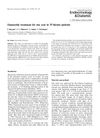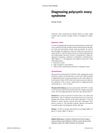Treatment Options for Polycystic Ovary Syndrome
February 2011
in “
International journal of women's health
”
polycystic ovary syndrome PCOS hirsutism alopecia weight loss lifestyle changes laparoscopic ovarian drilling clomiphene citrate tamoxifen aromatase inhibitors metformin glucocorticoids gonadotropins in vitro fertilization endometrial hyperplasia endometrial carcinoma anovulation hair loss weight reduction IVF
TLDR Different treatments for PCOS focus on the specific symptoms, with weight loss and lifestyle changes being important.
The document reviewed various treatment options for polycystic ovary syndrome (PCOS), emphasizing the importance of individualized treatment plans based on symptoms and reproductive goals. Lifestyle modifications like diet and exercise were fundamental. Pharmacological treatments included oral contraceptives for menstrual regulation, anti-androgens for hirsutism and acne, and metformin for improving insulin sensitivity and ovulation rates. Clomiphene citrate and aromatase inhibitors were effective for inducing ovulation, while laparoscopic ovarian drilling and in vitro fertilization were options for resistant cases. Alternative medicine, particularly acupuncture, showed promise. Despite the variety of treatments, their effectiveness varied, and some had significant side effects, highlighting the need for further research.









